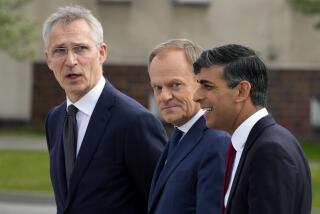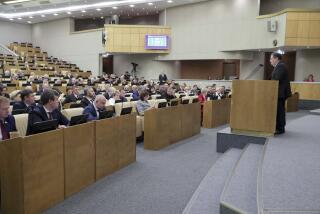Japanâs Defense Outlay to Rise Above 1% Limit
TOKYO â The Cabinet voted Tuesday to boost defense spending above the decade-old, self-imposed ceiling of 1% of gross national product, prompting praise from the U.S. military but causing the domestic opposition to warn against a new militarism.
Prime Minister Yasuhiro Nakasone quickly pledged, however, that âJapan will not become a military power.â
Nakasone told reporters that the decision to abolish the 1% ceiling was made to give the nation âa minimumâ of military strength.
The Cabinetâs action gave approval to a decision made late Monday by leaders of the governing Liberal Democratic Party to increase the 1987 military budget by 5.2% to $21.9 billion. That figure represents 1.004% of GNP, while defense spending this fiscal year was 0.993% of GNP.
Foreign Aid to Rise
Overall, the $338.1-billion fiscal 1987 budget is only 0.02% bigger than this yearâs, the smallest increase in 32 years. Aside from defense spending, the only other notable increase is in foreign aid, which rises 5.8% to $4.1 billion in the fiscal year starting April 1.
Japanâs Parliament is controlled by the governing party and is expected to approve the budget before the new fiscal year begins.
Defense Agency chief Yuko Kurihara told reporters, âWe tried to keep defense spending within the 1% limit, but the economic growth rate has slowed down.â A faster growing GNP would give Japan more leeway to remain within the old limit.
âOn the other hand, we must continue our defense buildup as planned,â Kurihara said. âWe hope to have the understanding of the public.â
Military spending is a sensitive issue in Japan, where a constitution adopted after World War II bans war as an instrument of foreign policy.
Washingtonâs Position
The Cabinet set the 1% ceiling in 1976 in response to criticism that military spending was increasing rapidly. The ceiling has been adhered to by all Japanese governments since then.
But the United States, which has a mutual defense treaty with Japan and stations about 61,000 troops here, in recent years has urged Japan to build up its defensive strength more rapidly.
In Washington, U.S. Defense Secretary Caspar W. Weinberger welcomed the planned budget increase.
âWe greet this with great pleasure from every point of view,â he told a news conference, adding that it will âenable all of us to do the job more of protecting freedom.â
Small opposition parties and Japanâs Asian neighbors--many of whom Japan occupied in World War II--have expressed fears that Japan will re-emerge as a military power.
âReleasing this (1%) brake means not only that the Nakasone Cabinet is trampling over a self-imposed pledge, it is a rash act that greatly deviates from the principles of the peace constitution,â Socialist Party leader Takako Doi said in a statement.
âUnforgivable Actâ
Communist Party Chairman Mitsuhiro Kaneko issued a statement denouncing the decision to exceed the ceiling as âan unforgivable rash actâ and said it was âNakasoneâs declaration toward a large military expansion.â
The Defense Agency said the increased funds will be used to buy 12 more F-15 fighter planes and nine more P-3C anti-submarine aircraft; increase the number of regular military personnel by 510 and the number of reservists by 1,500, and extend training hours for pilots.
The regular forces currently number 272,768 and reservists total 44,900, Maj. Chitoshi Harada, a Defense Agency spokesman, said.
The agency originally sought a 6.7% budget increase, and Harada said officials still have to pare some items from the spending plan.
Kyodo News Agency quoted Nakasone as saying that the increase was necessary for the government to fulfill its 1986-90 defense buildup plan.
More to Read
Sign up for Essential California
The most important California stories and recommendations in your inbox every morning.
You may occasionally receive promotional content from the Los Angeles Times.










